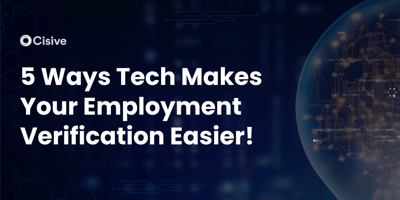

Employment verifications are an essential part of the hiring process. They help employers hire only...

In today’s competitive job market, employers are turning to artificial intelligence (AI) and machine learning algorithms to improve their hiring processes. While these tools can be incredibly useful and time-saving, AI hiring bias is a risk employers can’t ignore. Companies must determine how to use AI effectively while staying in compliance.
Learn how employers are already using AI in hiring, how to detect AI-related bias, and how AI’s underlying data and algorithms can improve hiring equity rather than adding to the problem.
The use of AI and automation in hiring is increasing, and for good reason. AI-based solutions are capable of quickly processing large amounts of data and producing useful insights as companies try to fill openings. These AI solutions can sort through resumes, score applicants, match a job opening’s desired skills against those of the candidate pool, and even recommend which applicants to interview. Moreover, AI systems can do these tasks faster than a human.
AI-based tools can also automate other aspects of the hiring process, such as scheduling interviews. This improves efficiency and can even reduce potential unconscious bias from human recruiters. AI can also combat bias by analyzing job descriptions, job postings, and other communications for discriminatory language or patterns. AI-based tools can also identify unconscious bias in the recruitment process by analyzing hiring decisions over time.
Employers can create a fairer hiring environment for all candidates by using automated systems powered by AI and machine learning. When used alongside human recruiters, AI hiring tools can save time, streamline processes, and even improve hiring outcomes.
Even though AI can reduce human bias, the technology itself can introduce bias that can be difficult to detect, isolate, or remove.
AI hiring bias occurs when algorithms used in hiring systems produce results that are unfair or discriminatory, such as favoring or disfavoring candidates based on race, gender, age, or other protected attributes. AI hiring bias can result from biased historical data, flawed algorithms, or improper implementation. It can lead to unequal opportunities for job candidates and perpetuate systemic inequalities in the workforce.
AI-powered hiring systems are designed to identify job-relevant patterns and trends in data sets and use these patterns to inform hiring decisions. But even if the system doesn’t act with bias, the underlying algorithm or data sets could be flawed. This can lead to bias in favor of certain traits or characteristics, such as gender, race, or educational background, that aren’t relevant to job performance.
AI-related bias in hiring is a major concern for employers, as it can lead to hiring decisions based on unimportant or even illegal factors.
Here are the top three risks of AI bias in hiring.
AI algorithms may favor certain types of candidates, leading to an unbalanced candidate pool and a lack of workplace diversity. This might not be deliberate: Flawed AI hiring processes can lead to the unintentional exclusion of certain groups of people when making employment decisions.
Consider AI hiring bias during video interviews, which can manifest when facial recognition technology or voice analysis algorithms favor certain traits or characteristics, leading to biased outcomes.
For example, if an AI system is trained on historical data that predominantly features one demographic group, it may unintentionally rate candidates from that group more positively based on facial expressions, tone of voice, or speech patterns. Such bias can create disparities between groups of candidates, depending on whether they meet the training data’s preferences.
When AI algorithms aren’t programmed thoughtfully and deliberately, they can produce unexpected results, leading to hiring decisions that might not be in the organization’s best interests.
One such scenario is an employer using an AI tool to shortlist candidates for a data scientist role. The tool inadvertently overweights a candidate’s social media presence as representing professional authority. As a result, a highly skilled and experienced candidate might be rejected because they don’t fit the AI’s biased perception of an “ideal” data scientist, while a less qualified candidate with a strong online presence is advanced in the process.
Such unpredictable outcomes can occur when AI tools consider irrelevant factors or over-index certain characteristics. The solution is to carefully configure AI systems and monitor their decision-making processes.
AI-based hiring processes can contribute to discrimination against certain groups, which can result in regulatory scrutiny and legal risk from lawsuits.
For instance, these processes might favor candidates from certain educational backgrounds or locations, disadvantaging those who don’t fit these criteria but have relevant skills and experiences. Such biases can have significant consequences for organizations, including legal action from individuals or groups who believe they were unfairly treated.
Furthermore, regulatory bodies are scrutinizing AI-driven hiring practices to ensure compliance with anti-discrimination laws. The Equal Employment Opportunity Commission (EEOC), for example, publishes AI guidance on an ongoing basis as the technology evolves. Organizations found in violation can face fines, penalties, or mandated corrective actions.
Detecting AI bias in the hiring process can be a complex and time-consuming process, but it’s essential for using AI solutions effectively. This work should be ongoing, with regular audits to ensure bias hasn’t taken hold over time.
To detect potential bias, employers need to audit existing tools and algorithms, analyze the data used to train algorithms, and review how AI decisions are interpreted and implemented. They should also test the accuracy of AI-based hiring decisions against known standards.
Here are five steps you should take to protect yourself from AI hiring bias
The first step for employers is to conduct an audit of existing tools and algorithms, especially AI-powered tools and systems being used for recruitment purposes, such as applicant tracking systems or resume screening software.
As part of your AI audit, conduct blind tests using diverse candidate profiles to evaluate whether the AI system produces equitable results. Besides an AI bias audit, assess whether these tools provide accurate and useful insights that meet your organization’s needs.
The next step is to analyze the data used to train algorithms. The data used in training sets can have a huge impact on the outcomes produced by AI-based hiring tools. Bias in the data can introduce prejudice into decision-making processes. Analyze whether training sets are representative of the target population. If not, the data won’t help you achieve fair and equitable hiring outcomes, even if it’s otherwise clean data.
Ask questions such as:
Evaluate the interactions between AI-based hiring tools and recruiters, HR, and hiring managers. What kind of human oversight is involved in decisions made by AI-powered solutions? What kind of transparency exists around this process? Are your hiring and recruitment tools “glass box” or “black box”?
Glass box AI hiring solutions are transparent and explainable systems that provide insights into how AI algorithms make decisions. They allow users to understand the factors and data that influence candidate assessments.
Black box AI hiring solutions are opaque systems where the decision-making process is hidden or difficult to explain. Users might lack visibility into how the AI arrives at its recommendations, making it challenging to understand the criteria and evaluate its effectiveness.
Where possible, choose glass box solutions that facilitate human oversight.
Finally, employers should test the accuracy and fairness of AI-based hiring decisions against known standards, ethical guidelines, and industry best practices. This helps ensure that the AI tools are an improvement on traditional methods of evaluating candidates and making hiring decisions.
By considering ethical issues, employers have a better chance of giving all job seekers a fair evaluation based on merit while avoiding potential legal issues related to bias.
Even if your current AI setup is bias-free, companies are constantly adding new data or adopting new and improved algorithms. Regular audits are required to ensure that any new data doesn’t introduce bias
Make sure humans are involved in this process. Manual review will help ensure that any potential bias is identified and addressed.
AI isn’t the only source of bias in hiring, and there remains much employers can do to reduce bias throughout the hiring process. By auditing all processes, language, and behaviors, employers can minimize the chances of embedding bias in AI-powered workflows.
By regularly auditing job postings and descriptions, organizations can contribute to fairer and more diverse hiring practices. To conduct such an audit, start by reviewing the language used in your job listings. Look for biased terms or phrases that may unintentionally discourage certain groups from applying. Pay attention to gender-neutral language and potentially biased adjectives.
Make sure that the qualifications and requirements are truly necessary for the role. Many companies default to requiring a college degree for all roles, even those where that requirement is debatable. Additionally, remove any references to age, race, gender, or other protected characteristics that aren’t essential for job descriptions. Finally, consider conducting diversity training for employees involved in creating job postings to raise awareness of potential biases and deliver a more inclusive recruitment experience.
Implementing blind hiring and screening processes is an effective strategy to reduce bias. To do this, start by removing personally identifiable information such as names, addresses, and photos from resumes and applications. Focus solely on qualifications, skills, and experiences when evaluating candidates during the initial screening phase. Use standardized scoring or rubrics to objectively assess these qualifications.
Additionally, consider anonymizing work samples or assessments candidates are asked to complete. By adopting these practices, organizations can prioritize merit-based evaluations, minimize unconscious biases, and make it more likely that new hires are selected for their skills and qualifications.
With blind screening processes in place, it’s easier to apply AI without feeding into potential biases.
For diverse candidates to have a realistic chance of being hired, you need a diverse slate at the top of the funnel. By reaching a broader audience, organizations increase the chances of attracting candidates with a variety of backgrounds, experiences, and perspectives. This diversity helps counteract biases that may arise from limited candidate pools and homogeneous networks.
A diverse candidate pool enhances the organization’s ability to select the best talent based on merit rather than favoring certain groups. It promotes fair competition among candidates and produces a workforce that reflects the diversity of broader society.
Standardizing interview questions can minimize variability at this key stage of the hiring process, improving interview quality, consistency, fairness, and objectivity. Standardized questions are designed to assess specific job-related skills, qualifications, and competencies. By focusing on these factors, interviewers are less likely to consider irrelevant or biased information, such as personal characteristics.
When every candidate answers the same set of standardized questions, it becomes easier to compare their responses objectively. This facilitates a fairer and more data-driven decision-making process.
In this evolving landscape, the future of hiring belongs to those who embrace the transformative possibilities of AI while diligently working to minimize its inherent risks.
While the promise of AI is immense, unlocking its full potential requires ongoing vigilance and responsible use. By adopting proactive measures like objective training data, continuous monitoring, and transparent algorithms, you can deploy AI as a powerful tool to identify the best talent while championing equity and diversity.
Some of your greatest allies in applying AI in hiring while minimizing bias are your hiring tech vendors, like Cisive. Although we use AI tools to improve efficiency, our platform requires human interaction by the client to decide whether adverse action should be taken on a candidate — maintaining human oversight and decreasing risk.
Find out how HCM technology from Cisive can help you combat AI hiring bias and improve hiring outcomes through the consistent delivery of a fair process. Schedule a call with one of our experts today.

Employment verifications are an essential part of the hiring process. They help employers hire only...

Employers rely on background checks to maintain a safe and productive work environment. As you vet...

Recruiting and hiring remote employees on a global scale is challenging—even large enterprise...